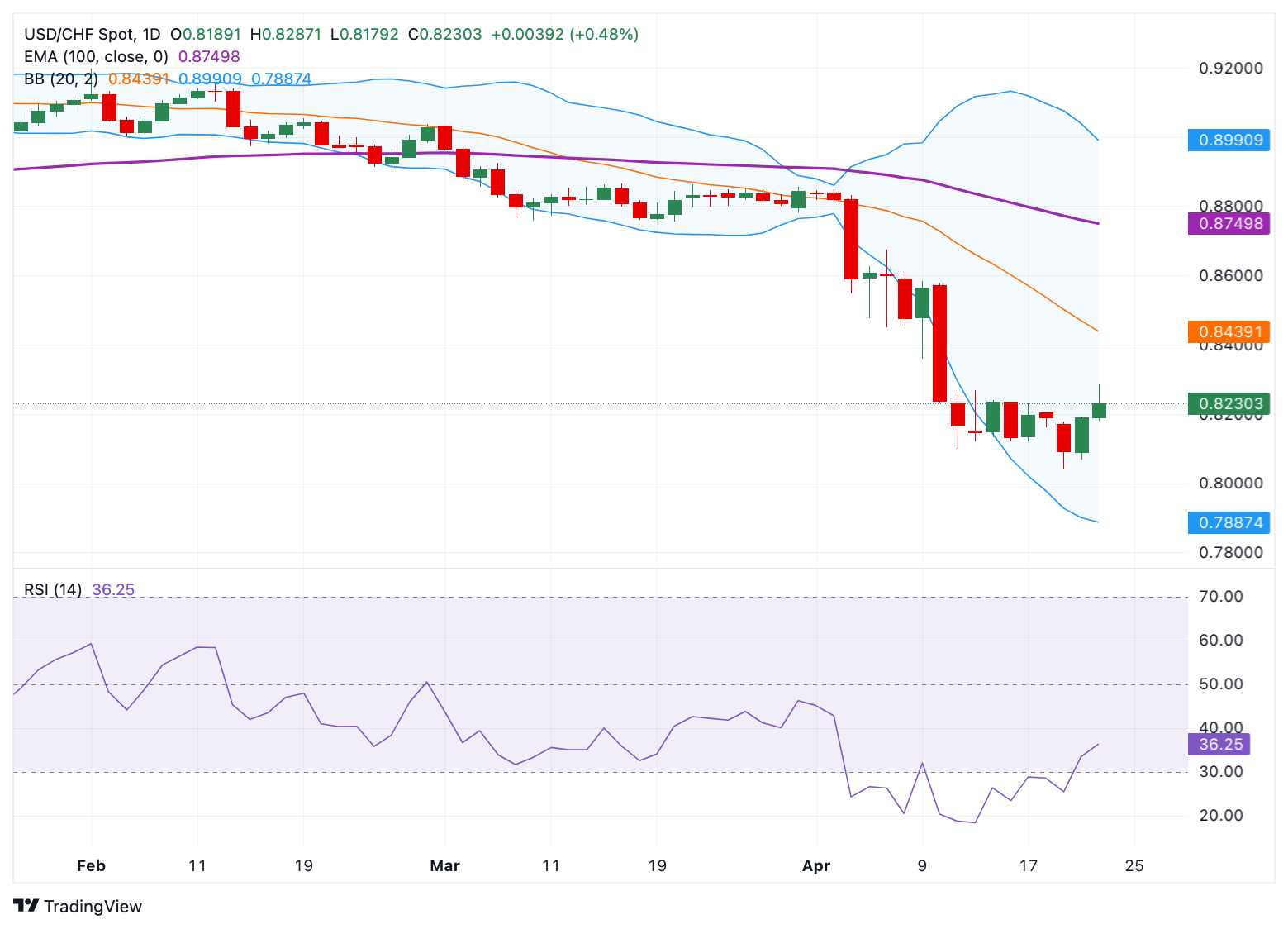USD/CHF Price Forecast: Outlook remains bearish below 0.8250
- USD/CHF gains traction to around 0.8225 in Wednesday’s early European session.
- The negative outlook of the index remains in play below the 100-day EMA with a bearish RSI indicator.
- The first support level to watch is 0.8121; the immediate resistance level is seen at 0.8360.
The USD/CHF pair drifts higher to near 0.8225 during the early European session on Wednesday, bolstered by the renewed US Dollar (USD) demand. Hope for the US-China trade deal provides a boost for investors. Additionally, US President Donald Trump backed away from threats of firing Federal Reserve (Fed) Chair Jerome Powell, which provides some support to the Greenback.
According to the daily chart, the bearish sentiment of USD/CHF prevails as the pair is below the key 100-day Exponential Moving Average (EMA). Furthermore, the downward momentum is supported by the 14-day Relative Strength Index (RSI), which stands below the midline near 36.0, supporting the sellers in the near term.
The initial support level for the pair emerges at 0.8121, the low of April 16. Further south, the additional downside filter to watch is 0.8040, the low of April 21. The key contention level is seen at the 0.8000 psychological level.
On the flip side, the first upside barrier for USD/CHF is located at 0.8360, the low of April 9. Any follow-through buying above this level could pave the way to 0.8609 the high of April 8. A decisive break above the mentioned level could see a rally to 0.8750, the 100-day EMA.
USD/CHF daily chart

Swiss Franc FAQs
The Swiss Franc (CHF) is Switzerland’s official currency. It is among the top ten most traded currencies globally, reaching volumes that well exceed the size of the Swiss economy. Its value is determined by the broad market sentiment, the country’s economic health or action taken by the Swiss National Bank (SNB), among other factors. Between 2011 and 2015, the Swiss Franc was pegged to the Euro (EUR). The peg was abruptly removed, resulting in a more than 20% increase in the Franc’s value, causing a turmoil in markets. Even though the peg isn’t in force anymore, CHF fortunes tend to be highly correlated with the Euro ones due to the high dependency of the Swiss economy on the neighboring Eurozone.
The Swiss Franc (CHF) is considered a safe-haven asset, or a currency that investors tend to buy in times of market stress. This is due to the perceived status of Switzerland in the world: a stable economy, a strong export sector, big central bank reserves or a longstanding political stance towards neutrality in global conflicts make the country’s currency a good choice for investors fleeing from risks. Turbulent times are likely to strengthen CHF value against other currencies that are seen as more risky to invest in.
The Swiss National Bank (SNB) meets four times a year – once every quarter, less than other major central banks – to decide on monetary policy. The bank aims for an annual inflation rate of less than 2%. When inflation is above target or forecasted to be above target in the foreseeable future, the bank will attempt to tame price growth by raising its policy rate. Higher interest rates are generally positive for the Swiss Franc (CHF) as they lead to higher yields, making the country a more attractive place for investors. On the contrary, lower interest rates tend to weaken CHF.
Macroeconomic data releases in Switzerland are key to assessing the state of the economy and can impact the Swiss Franc’s (CHF) valuation. The Swiss economy is broadly stable, but any sudden change in economic growth, inflation, current account or the central bank’s currency reserves have the potential to trigger moves in CHF. Generally, high economic growth, low unemployment and high confidence are good for CHF. Conversely, if economic data points to weakening momentum, CHF is likely to depreciate.
As a small and open economy, Switzerland is heavily dependent on the health of the neighboring Eurozone economies. The broader European Union is Switzerland’s main economic partner and a key political ally, so macroeconomic and monetary policy stability in the Eurozone is essential for Switzerland and, thus, for the Swiss Franc (CHF). With such dependency, some models suggest that the correlation between the fortunes of the Euro (EUR) and the CHF is more than 90%, or close to perfect.


